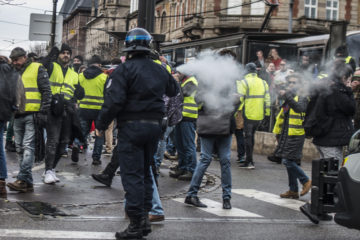On Saturday France withstood the thirteenth round of mobilisation from the movement “the Yellow Vests”, with 52,000 protesters turning out around the country. Since the movement began as an online petition last November nearly one million demonstrators have turned out, including 282 000 on the first weekend. This movement that has been shaking French democracy for over two months is first set apart by its unprecedented violence. Despite the penchant of the French for for taking to the streets, no one could have predicted the violence and savagery this would unleash. It is precisely because of this aspect that the movement caught worldwide attention and damaged not only France’s image but Macron’s presidency. Images of Paris looking like a battlefield have circulated in the international press. Between setting cars on fire and clashes with the police, it seems there is no line the Yellow Vests will not cross. Exhausted from the over-mobilisation, some police officers have even joined the movement. Over the course of the protests, 11 people have died and hundreds have been wounded. The damage has been extensive, reaching an estimated cost of 1.5 million euros to be compensated for.
But who are the Yellow Vests and where is all this anger coming from? The petition that started the protest was initially directed against a fuel tax announced by the government in early November. It was mainly driven by the middle classes, which are charged the highest tax rate in France. The tax was, justifiably, seen as another burden they could not afford. After the first round of protests, the government announced the tax would not be implemented. But the movement has since then moved far beyond the tax and now turned into a nationwide backlash against Macron’s government. It seems that the tax was the straw that broke the camel’s back and has now faded behind a long list of graver grievances. But why is this an issue at all in one of the few countries where the standard of living has not decreased since 1980? And why do protesters take to the streets in the country with the highest minimum wage and most generous welfare system to revive the class struggle? Is this simply the French penchant for painting everything in black or is it part of something bigger?

The leaderless nature of the movement and its lack of unification make it hard to pick up what precisely the Yellow Vests are asking for. This is also one of the reasons why the government cannot handle it effectively. If the movement was first and foremost driven by those who struggle with the minimum wage, it has now found resonance amongst various social groups. The heterogeneity of the movement adds to the complexity of understanding what the protesters specifically want beyond economic justice. It is, however, possible to isolate the main demands amongst the multiple voices that make up the movement. The main concern seems to be purchasing power, with demands for a 15 percent raise of the minimum wage as well as an increase in participatory democracy. The violence of the movement has already led the government to make concessions in an attempt to pacify it, such as increasing the minimum wage by 6 percent. But despite that and diminishing participation, national support for the movement remains strong.
The most daunting demand that has been made so far is for Macron’s resignation: “Macron, résigne” are the two most represented words on the Yellow Vests’ slogans. Indeed, Macron is the primary target of people that no longer feel represented by their government. There is, in fact, a disturbing echo of the French Revolution in the slogans used by the Yellow Vests, such as references to the “bourgeoisie” or the use of Phrygian caps, which were the symbol of the revolution. As it was in 1789, the anger is now largely motivated by a general feeling of political disenfranchisement and of being cheated and neglected by the political elite. It seems to many French people that they have been abandoned by a government out of touch with reality. This has a lot to do with some of Macron’s remarks, widely seen as tactless, such as telling a young unemployed he “only had to cross the street to find a job” or that train stations were places “you found those who succeed and those who are nothing.” Such comments have gained him the title “president of the rich.” There is an existential rage driving the movement and their desire to wreck Macron’s presidency. Whether it is because of food shortages or taxes, the symbolic figure of the common man fighting against the political elite has once again appeared on the French scene. And it seems that just like in 1789, only the president’s head will curb the violence.
To avoid the King’s fate, who died under the guillotine after failing to quell popular discontent, Macron has vowed to reform. The president proclaimed a “grand national debate” in late December to show that he understood the people’s anger and hoped to “transform anger into solutions.” Specifically, the “grand debate” is an attempt to restore order by bringing the political decision-making closer to the people. Macron has travelled to schools and prefectures to hear people’s grievances. His hope is that the discussions will generate new policy ideas. But mostly, they are supposed to dismantle the critique that the President does not care about the concerns of ordinary people by giving the average French person a chance to express those concerns. But whether the Yellow Vests will accept to join the negotiating table and whether Macron’s failure to connect with the population can be mended remains to be seen.


